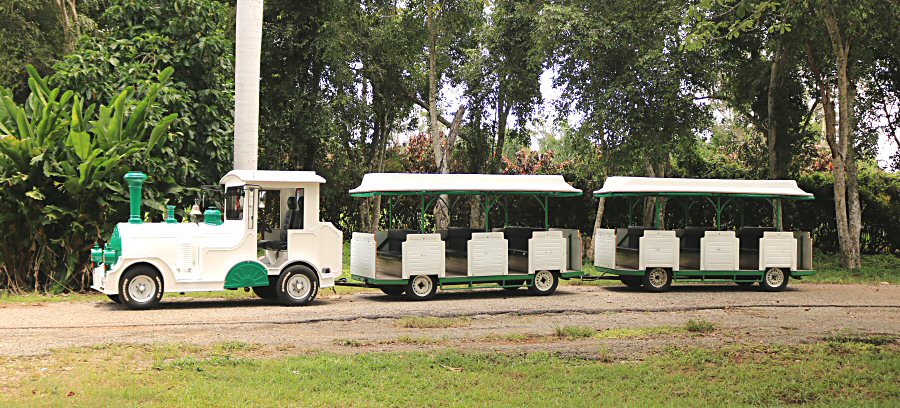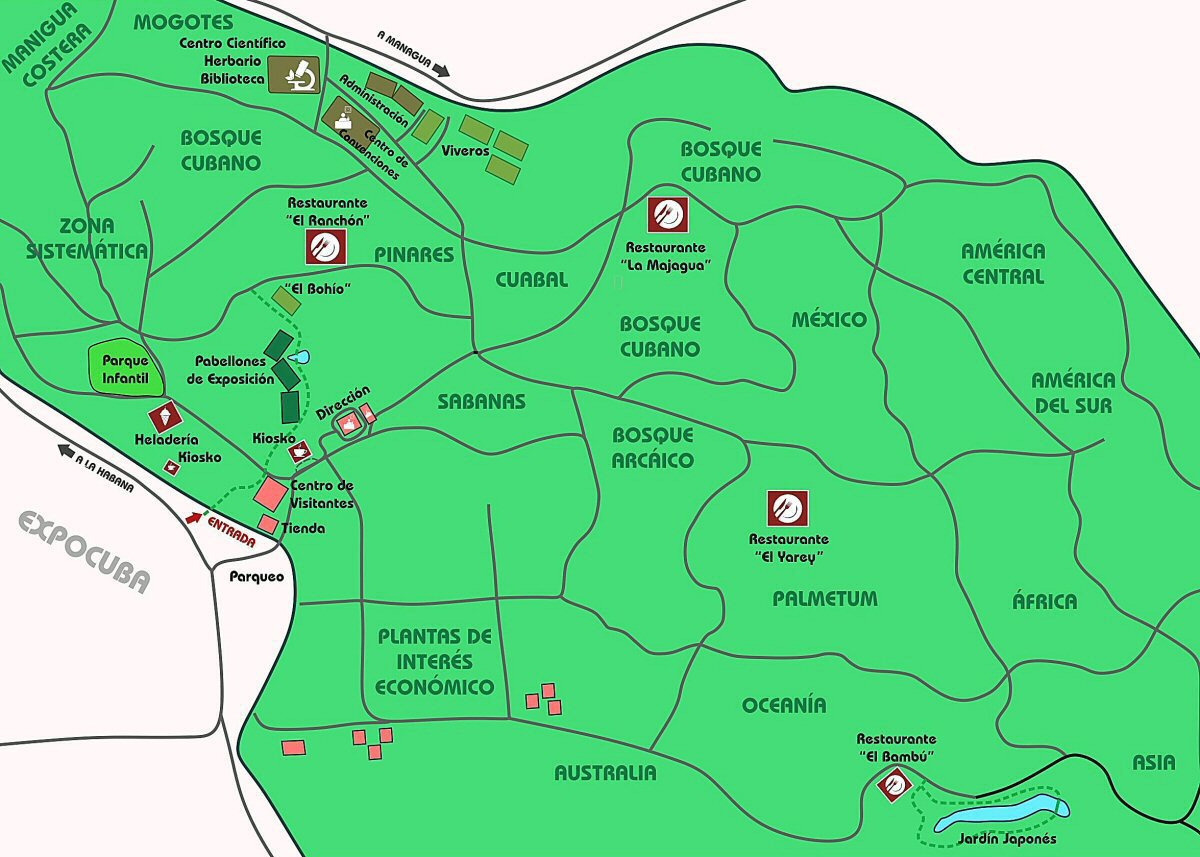BOTANICAL GARDEN
The area open to visitors covers approximately 2,353 m². It
consists of an indoor area with three pavilions that are
located near the entrance, and an outdoor area with a pond
for aquatic plants and ornamental plant collections.
The pavilions are 9 meters high and display plants of
approximately 600 species belonging to 90 families. These
metal-framed pavilions, one roofed with glass and two with
shade mesh, in which plants that inhabit the world's arid
regions, arranged geographically, and plants from tropical
rainforests are displayed in aesthetic arrangements based on
ecology.
The
Glass House Pavilion is dedicated to representing plants
from tropical and subtropical arid zones. It is also a place
where scientific collection is stored.
The
High Humidity and 50% Lighting Pavilion houses plants that
inhabit tropical rainforests.
The
High Humidity and 25% Lighting Pavilion displays plants
from tropical rainforests and some economically valuable
plants such as cocoa, coffee, black pepper, and vanilla.
In these pavilions, it is possible to see beautiful examples
of bonsai, the art of growing artificially dwarfed trees and
shrubs in pots for ornamental purposes.
An artificial lake in the complex houses the
Aquatic Plants
Collection which, as its name suggests, brings together
species that inhabit freshwater bodies. There you will see
the cork palm (microcycas calocoma), considered a living
fossil and a collection of aquatic and terrestrial
ornamental plants, with a section dedicated to plants with
thickened trunks used to store water.
The outdoor area that once housed cattle farms, occupies the
largest portion of the land. The National Botanical Garden
is divided into 25 zones, each dedicated to a specific
geographic region with rigorous scientific planning and
landscape design of 350,000 trees of more than 3,000
species. The exhibition pavilions, the outdoor collections,
and the Japanese Garden complete an interesting and
informative tour for the visitor. These zones are the Cuban
Phytogeographic Zone, the World Phytogeographic Zone, the
Systematic Zone, the Japanese Garden, the Palmetum, the
Ornamental Zone and the Cultivated Plants Zone.
The
Cuban Phytogeographic Zone comprises the following collections of Cuban phytogeography, such as
semi-deciduous forest, dry mountain, mogotes, júcaros and
Palmas savannas, pinewood, cuabal and coastal jungle.
Semi-deciduous forest is a forest that predominated in the
flat and hilly areas throughout the country. It suffered
indiscriminate felling of almost its entire area. It is
characterized by valuable hardwood trees, such as the Royal
Palm.
Dry mountain is a forest that predominates in coastal areas,
characterized by hardwood trees and shrubby cacti.
Mogotes are a vegetation complex found on karst elevations.
The best known and richest in flora are the mogotes of the
Sierra de los Órganos in Pinar del Río, with high, almost
vertical cliffs and "dog-tooth" peaks. They are home to
highly specialized species exhibiting a high degree of
endemism. Generally a semi-deciduous forest grows at their
base.
Júcaro and Palm Savannah are areas where the ground floods
during the rainy season, with scattered trees and palms,
among which the júcaro, the cana palm, and the palms of the
Copernicia genus predominate.
The pine forest is the only type of coniferous forest in the
country, where the pines Pinus caribaea and P. tropicalis
predominate in Pinar del Río and Isla de la Juventud, Pinus
cubensis in the mountains of the Nipe Sagua Baracoa Massif,
and Pinus occidentalis in some localities of the Sierra
Maestra. The understory of these pine forests is generally
very rich of endemic species.
Cuabal is a scrubland found on poorly developed soils
derived from serpentine rock, forming a nearly central axis
on the island of Cuba. Its flora is highly endemistic.
The coastal bushland is a scrubland present on the high
coasts, with little soil development and the presence of
cacti and very xerophilous plants.
The
World Phytogeographic Zone consists of the plant
formations from the regions, such as Australia, Oceania,
Asia, Africa, South America, Central America, Antilles and
Mexico.
The highlight of the Botanical Garden is the
Japanese Garden
(El Jardín Japonés). Designed by the late Osaka-based
Japanese landscape architect Yoshikuni Araki, the Japanese
Garden is a "Kaiyu-Shiki-teien" garden, literally meaning
"Walking Garden." Covering an area of five hectares, the
garden is arranged around an artificial oval lake, 300
meters long and 750 meters in circumference. Of particular
interest are the presence of a waterfall, two meditation
pavilions, and a hexagonal wooden pavilion perched on stilts
within the lake. It is called "Ukimi-dou," meaning "Pavilion
on the Waters."
The plants we can see here are from the Asian region in
general, as well as from different countries whose shape,
texture, or flowering qualities meet the design
requirements.
On one side of the path, a natural stone pool, or "tsukubai,"
where water flows through bamboo canes, invites visitors to
wash their hands. Further along, also by the roadside,
stands a stone lantern of great significance in Japanese
culture. To the right of the grand waterfall, a stone tower
composed of 13 horizontal segments stacked on top of each
other is a replica of a traditional Buddhist pagoda.
El Bambú Eco-Restaurant, nestled in the beautiful setting of
the Japanese Garden, is a must-see. In addition to its
stunning views, the restaurant actively promotes new
plant-based eating habits, using approximately 300 species
and varieties.


